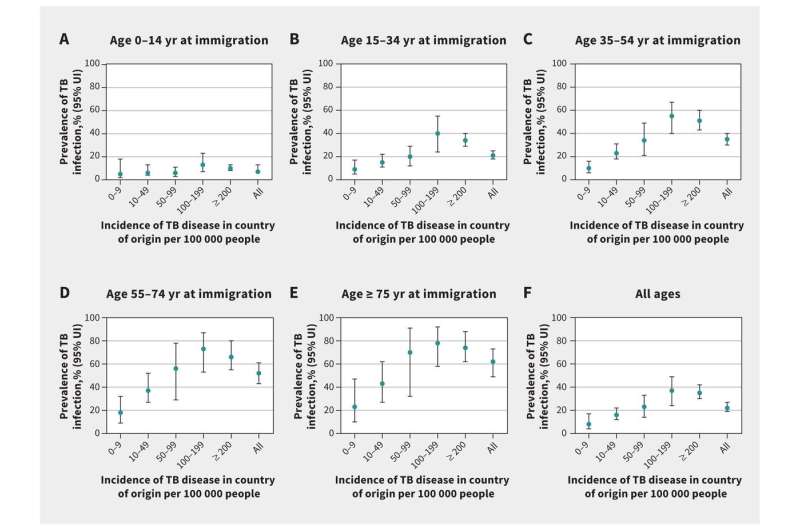This article has been reviewed according to Science X's editorial process and policies. Editors have highlighted the following attributes while ensuring the content's credibility:
fact-checked
peer-reviewed publication
trusted source
proofread
Focused screening of new residents is key to fight TB in Canada

According to the World Health Organization (WHO), tuberculosis (TB) caused 1.3 million deaths in 2022 and is still very much present in many countries. In Canada, where foreign-born residents bear 80 percent of the burden of TB, the annual incidence rate is close to 5 cases per 100,000 persons, far from the WHO's goal to reduce it to one case per million inhabitants.
A new study by researchers at the Research Institute of the McGill University Health Centre (RI-MUHC) found that approximately one in four foreign-born Canadian residents is infected with TB, but very few of them were infected within the last two years, the period of highest risk for progression to the active form of the disease.
The authors of the study newly published in Canadian Medical Association Journal suggest that prevention strategies should prioritize infection screening for new permanent residents from countries where the incidence of TB is high. It would be costly and ineffective to test people who have been in the country for more than two years.
"According to the World Health Organization, 5–10 percent of people infected with TB develop the disease in their lifetime. However, the risk of developing TB disease is 25–50 times higher within the first two years of acquiring the infection compared to when more years have elapsed," explains Dr. Kevin Schwartzman, senior scientist in the Translational Research in Respiratory Diseases Program at the RI-MUHC, professor of Medicine at McGill University and co-senior author of the study.
"Our study suggests that among all foreign-born Canadian residents infected with TB in 2021, only 1 in 488 were infected in the two years prior, with increased risk of developing TB disease."
"Preventive treatment of tuberculosis is highly effective in preventing the development of the disease in infected individuals. However, implementing widespread screening and treatment programs for TB infection would likely be prohibitively expensive and would mean treating a very large number of people at very low risk of developing the disease," adds Jonathon Campbell, Ph.D., junior scientist in the Translational Research in Respiratory Diseases Program at the RI-MUHC, co-senior author of the study.
"We conducted this study to help identify groups for whom screening would be more effective and would likely detect greater proportions of infections."
A clearer picture of the situation
Based on the results of the study, the estimated overall prevalence of TB infection among foreign-born people in Canada was 25 percent for the 2001 census year, 24 percent for 2006, 23 percent for 2011, 22 percent for 2016, and 22 percent for 2021, close to the global average of 23 percent. The researchers also observed that prevalence increased with age at migration and the incidence of TB in the country of origin.
Provincially, the estimated prevalence of infection in 2021 among foreign-born residents was lowest in Quebec (19%) and highest in Alberta (24%) and British Columbia (24%).
To produce these results, the researchers synthesized information about TB disease and infection rates in all countries of the world over the past 90 years to estimate how likely it is that people living in any given country were exposed to and infected with TB at any given year.
They linked this data to information from Canadian censuses, including the number of people living in Canada who came from each country, as well as their age and time spent in Canada. Their work revealed that foreign-born Canadian residents with TB infection were likely infected long before they migrated, and therefore, most are at low risk of developing the disease.
Progressing towards TB elimination
The authors of the study point out that, despite Canada's previous target of reducing the incidence of TB in Canada to 3.5 cases per 100,000 population by 2015, it remained at 4.8 per 100,000 in 2021. This despite the fact that Canada and the global community have agreed to end TB by 2030 as part of the United Nations' Sustainable Development Goals. The authors attribute the lack of progress toward TB elimination over the last decade to epidemiological changes and the lack of prevention strategies.
"Our study provides much-needed estimates and information on TB infection among foreign-born people living in Canada. We hope that it informs clinical and policy-level decision-making," says Aria Jordan, first author of the study and former master's student under Dr. Schwartzman.
More information: Aria Ed Jordan et al, The prevalence of tuberculosis infection among foreign-born Canadians: a modelling study, Canadian Medical Association Journal (2023). DOI: 10.1503/cmaj.230228


















